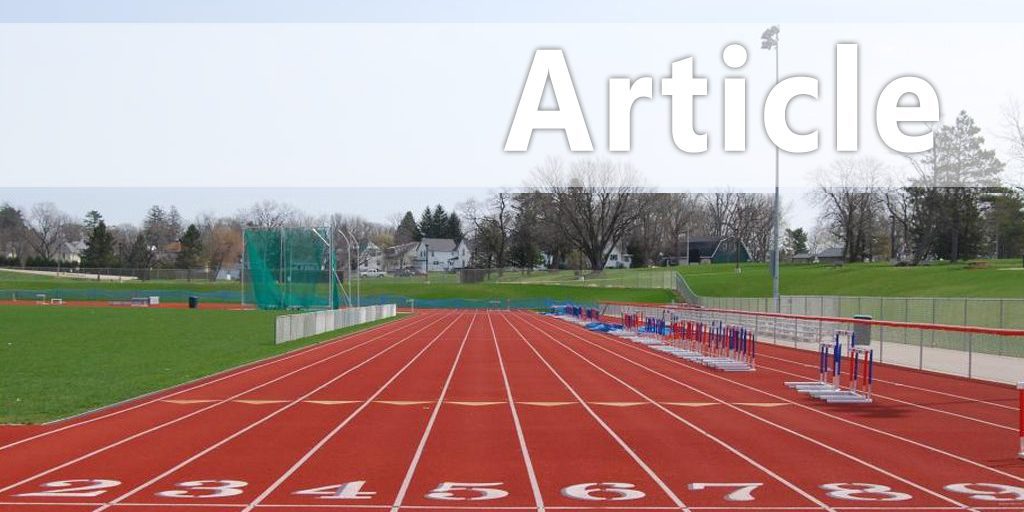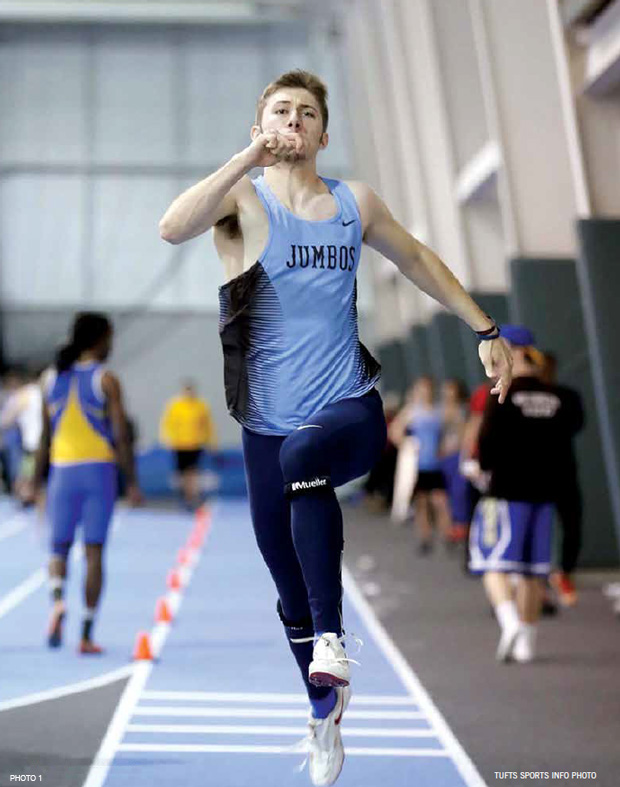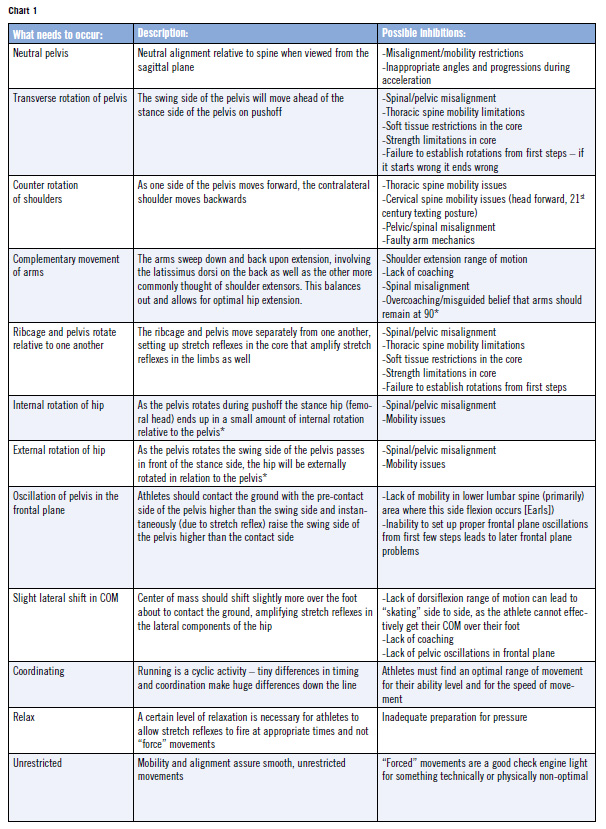| Running with Circles - Optimizing the Rotational Movements of the Core |
| By: Sam Wuest
Originally Published in: Techniques Magazine Provided by: USTFCCCA In the eastern concept of the body, there is a point called the "dantian," loosely translated to energy center. This point is located in the lower abdomen (roughly between the navel and sacrum), and is commonly considered almost a battery of energy for the human body. While this nuanced function of the dantian (that I will leave grossly simplified for the purposes of this article) is important for medicine and the internal workings of the organs and other aspects of a living, breathing, human, it is also commonly referenced in the eastern martial arts, where this central point of the human body is recognized as a vital source of both efficiency and power production. Tiny movements made at the core of the body, when coordinated and timed correctly, can create extremely high amounts of force at the extremities by taking advantage of the elastic myofascial chains that run from the center to the ends of the body. This highly coordinated skill is why a movement such as tai chi (the martial art, not the exercise-for-old folks version that has made its way into mainstream culture) was traditionally practiced so slowly - slowing it down was the only way a practitioner could feel the small, ripple like movements created in the pelvis and spine. Why bring this topic up in Techniques? Because the athletes we see winning races every year are moving the same way, across all events. (See photo 1) We as human beings like to overemphasize and oversimplify. We create models based on our limited 21st century perception of how the body works, and apply them daily. Having key performance indicators and having a general technical model that you are teaching is good coaching practice. However, problems arise when we forget that our models do not reflect reality, at least not as accurately as reality reflects reality. To illustrate this point, I'd like you to play along with me for a moment and draw for me an ideal first stride out of the blocks for a 100m sprinter, at the point where the front foot leaves the pedal. Go ahead, actually draw it. I would wager the finished product looks something like this: 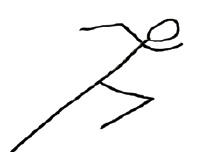  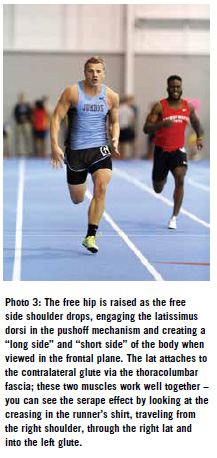 WHAT DOES THE PELVIS DO WHEN RUNNING? WHAT DOES THE PELVIS DO WHEN RUNNING?
In short, it oscillates. Dynamically revolving around a neutral position, the pelvis rotates in the transverse (rotational) plane around a central axis like a wheel turning back and forth, with the spoke of the wheel being the pelvis' center (similar to the dantian mentioned earlier). In the sagittal plane (viewing an athlete from the side), the pelvis transitions from positions of slight anterior and posterior tilt relative to the rest of the torso. This movement should be controlled, but not eliminated, a core braced so tightly that it cannot tilt at all would never win a race at any level, and should not be a desired outcome. Further in the sagittal plane, the pelvis even tilts relative to itself in healthy humans (with one side of the ilium tilting forwards and the other tilting backwards), as the pelvis made of several bones connected by elastic elements can and should be able to move in order to aid shock absorption from the ground and transfer elasticity. In the frontal plane, you see the pelvis again rotating like a wheel, back and forth with the free side of the pelvis rising above the stance side as an athlete finishes pushing off on the ground. Hip-knee-ankle triple extension is not sufficient to load the tissues elastically and create force the way nature intended us to, we must rethink this. Quadruple or quintuple extension doesn't have quite the same ring, but it is actually much more accurate. (See photo 3) WHY DOES THE PELVIS DO THIS? You need to get your athletes to move their hips for two main reasons. Optimal pelvic oscillations create a longer lever arm on the push-off mechanism during running and also create more optimal stretch reflexes and muscle sequencing. The first reason is quite simple. By adding an extra joint in which you can apply force, you can apply more force. The athlete has a greater windup without taking any extra time. Learning to use one's pelvis when running is effectively gaining longer legs. Athletes that use their pelvis well when running look more fluid and run faster. They beat you and they make it look easy. Longer levers lead to more speed at the end of those levers when their origin is moving at the same speed. Test it out. Try kicking a soccer ball while locking your pelvis in place, completely square to the direction you are kicking so that you cannot use forces in the transverse (rotational) plane. See how far it goes. Next, try relaxing it and swinging your kicking hip through the ball as you strike. I'm willing to bet that the second scenario both felt easier and that the ball went further. By engaging an extra joint, you effectively made the lever that is your "leg" longer, so the end of that lever (your foot) was moving with greater velocity, so the ball was accelerated with greater velocity, so the ball traveled a greater distance. It is important to keep in mind that we are not talking about overstriding and sticking one's foot way out in front, the athlete's thighs still are in the same position at footstrike, we are simply applying force through a longer lever. (See photos 4& 5)  The second reason is not quite as simple. The body was designed to be incredibly efficient during gait. While walking, running, and sprinting, we use our elastic stretch reflexes all the time both to save energy and produce greater power. When the hip extensors con-tract, the leg goes behind the body and a stretch reflex is produced in the hip flexors that aid hip flexion, and we walk on. Most people know this much. However, there is a lot of elasticity that falls by the wayside if an athlete does not learn to rotate their pelvis, counter-rotate their shoulders, and let each side of the pelvis rise and fall in a synchronized pattern. The stretch reflexes in the core are so powerful that some biomechanists have even asserted that are legs are unnecessary for gait, in the sense that in a lab where the only the muscles located on the abdomen were used one could still replicate human walking. There are strips of fascia criss-crossing the abdomen, shaping an "x", that are stretched and recoil to cause the knee to move forward after the hip is extended during pushoff (Earls). This is commonly referred to as the serape effect, as the x's resemble the traditional Mexican clothing. If no rotation occurs between the ribcage and pelvis, if they are "stuck" and don't move freely relative to each other, then we lose this potential elastic energy. Physicist Serge Gracovetsky, inventor of the spinal engine theory, believed that the spine itself and the fascial tensioning caused by the counter rotations of the pelvic and shoulder girdles work like winding and unwinding a spring. He states that "The lower extremity can be completely removed without interfering with the primary movement of the pelvis...it is obviously preferable to have legs, but they only amplify the movements of the pelvis, and their functional role remains secondary." (Gracovetsky) The stretch reflex generated in the core is amplified to the outer limbs of the body, making all locomoting movements more efficient and elastic. (See photos 6 & 7) 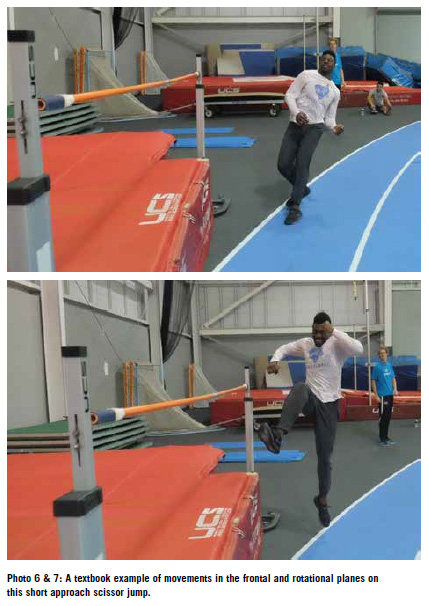 Sprints: look for large ROM in the frontal plane to assist in generating force to overcome inertia in the first few steps out of blocks Top Speed, Mid D, & Distance: look for movements in the frontal plane to assist in a "bounciness" of stride, while the counter rotation of shoulders and hips helps to again increase stride length without overstriding Hurdling Events: much the same as other coaching points for hurdles, going over the hurdle should be as much like a run as is possible. The pelvic undulations in the frontal plane are hugely important both for establishing good running off of the hurdle and also for clearance. Greater range of motion bringing the free side of the pelvis up towards the armpit as the trail leg passes through makes the hurdle easier to clear, as well as giving the trail leg more range of motion through which to apply force before it hits the ground. The rotational oppositions of the shoulder and hip axes are of major concern in creating balance over the hurdle to allow for smooth running off of them. The trail leg hip must come over and in front of the lead leg hip prior to the lead leg touching down. Over-focusing on foot quickness during hurdle drills leads some athletes to keep their hips too stiff to clear and run off of hurdles smoothly. You'll find most of your beginner and high school level athletes that tend to use 4 steps in between hurdles are not getting their trail leg hip above and past their lead leg hip prior to touchdown, or even at all. This range of motion is essential for speed in the 100/110's and for speed and efficiency in the 400's, where maintaining stride length, rhythm and fluidity are essential for success. High Jump: I firmly believe that the most underrated, and perhaps even most important reason why the Fosbury Flop is the sole high jump technique employed today on the international level is that it engages the frontal plane in ways which no other technique can. All great one legged jumpers in basketball (consciously or not) use a slightly curved approach to lower their center of mass prior to takeoff and also in order to engage the elastic components of the lateral hip more fully. Watch videos of Michael Jordan (or Zach Lavine for the younger folks) jumping from the free throw line to see what I'm talking about. There is a clear isometric pre-loading and eccentric phase of a one footed takeoff in which the swing hip dips below the takeoff hip before rising above the takeoff hip as the athlete leaves the ground, creating a takeoff position where the shoulders are level but the free side of the pelvis is markedly higher than the stance side (see example pictures above). This gives the athletes considerably more range of motion upon which they can apply force without sacrificing horizontal velocity. Without this movement occurring the athlete will not be able to convert their curved approach to increased takeoff. Long Jump: The body must shift its center of mass in the frontal plane so that it is more on top of the takeoff leg than a regular sprint stride would be in order to exaggerate the elastic loading of the takeoff leg. As a side note, and I am not advising anyone to start coaching this, I believe that Mike Powell's wide, stepping out penultimate step was a big part of his ability to jump 8.95 meters. It gives him a slightly larger frontal and transverse range of motion for the right side of his pelvis to swing up and through during takeoff because it begins its arc slightly off to the side of his center of mass. Again, not trying to change a technical model here, just a thought on why his style seemed to work so well for him. Triple Jump: the second and third phases of the triple jump are probably the easiest place to see the most obvious lateral and rotational movements of any non-throwing, linear event in track, apart from perhaps hurdles. Good bounding technique will result in the athlete looking "wound up" prior to contacting the ground, with the hip on the side about to strike higher and farther out in front than the other hip. This is essential and creates a longer lever arm from which to hit the ground and a longer arc for the swinging segments. The shoulder on the side of the raised knee, pre-contact, will actually be dipping in relation to the opposite side shoulder both in order to counter the frontal plane movement of the hips and because the center of mass should be more over the leg in regards to the frontal plane than it needs to be in running, in order to load elastic components particularly in the frontal plane. *Certain athletes (such as Usain Bolt and Asafa Powell, among others) will appear to be internally rotating at the hip socket while coming out of blocks, but this is primarily due to the rotation and hiking of the free side of the pelvis bringing their knee to the midline, not relative internal or external rotation of the hip to the pelvis. (See Chart 1)
DRILLS, CUEING & TRAINING IMPLICATIONS I should start this section by saying that I don't teach movements in different planes separately, I am simply writing a separate article to emphasize some areas that aren't talked about enough in my opinion. Training Implications: All athletes MUST train in all three planes of motion. In addition to going forward and backward (traditional training, if you will) they need to do lateral and rotational movements. Do I have my athletes sprinting sideways and squatting with one side of the barbell loaded? No. But we are including lateral and rotational movements in pretty much every multi jump, medicine ball, general strength, and restorative lift circuit. We'll even throw in more advanced exercises like rotational hurdle hops from time to time. Too often training in different planes is looked at as optional, it's necessary for athletes to learn and maintain good movement patterns and stay injury free. Drills: I don't do any drills separately to teach rotational and side movements, but I will take time to focus on particular movements during a certain exercise. For example, hurdle mobility is a great time to talk to your athletes about raising their free hip, as theoretically the hurdle is already teaching them to do so. Explicitly knowing why that is important, however, increases the likelihood of transfer to their event. Bounding is a great place to talk about movements in the core, as this is the locomotion activity with perhaps the largest pelvic range of motion that I use. Wickets, stick drills, stairs and hills can help athletes further engage their frontal and rotational planes. I will have my athletes do slower "bouncy" strides and single stair runs where they're mainly focused on the pelvic oscillations mentioned in this article. Variable takeoffs for jumpers in which the athlete puts their antepenultimate, penultimate or takeoff step on a small mat or box (think a couple inches) can help athletes to engage their frontal plane more to improve takeoff mechanics. Most coaches already do a lot of the right things in regards to the frontal and rotational planes, but your average athlete will struggle to pick up a technique unless they have a specific idea of what it is they're trying to accomplish. While a good training plan is necessary, let's not forget, coaching is all about communication and skills must be taught. Cueing: Cueing the frontal and rotational planes is not always separate from other cues. Getting athletes to hit a big split out of the blocks is a great way to encourage frontal plane mechanics, as are postural cues, such as anything related to a neutral pelvis or head, as this will allow the athlete to move safely with their spine and pelvis. A specific cue I will use during bounding is asking athletes to feel themselves winding and unwinding their torso. Another is asking athletes to feel one side of their side-body (hip a shoulder girdle) shortening while the other side lengthens. Hip up and through is a cue I'll give more to athletes doing hurdle mobility and possibly wickets, as I'd rather emphasize the application of force into the ground when possible. The same rules of cueing apply here that always apply to our sport, as well. In particular, I think of how many Boo Schexnayder clinics have drilled into my head that things must start well to end well - i.e. bad starting position/ accel mechanics will lead into bad top speed mechanics no matter how well you coach top speed mechanics. In this case, if an athlete starts running with a stiff pelvis and bad posture, they will always display bad or forced pelvic oscillations. The easiest way to get them to engage their frontal and rotational aspects is to get them to do it immediately upon starting, establishing large ranges of motion in the frontal plane. Getting them to focus on sweeping their arms down and back, engaging their shoulder deeply (including the latissimus dorsi) is a good way to cue during acceleration. CLOSING REMARKS An athlete that runs using their pelvis essentially has an extra joint competing against an athlete who does not. The athlete that runs in such a way that allows the oscillations of the pelvis to aid in power production and elasticity of their run or jump has effectively increased the length of the lever arm of their legs. If two athletes each have 32-inch-inseam-length-legs, to measure as scientifically as possible, and athlete A runs with the pelvis moving in concert with the rest of her body and the athlete B holds her pelvis completely rigid, then athlete A will run with perhaps a 34" length leg to B's 32, and that is before one even considers the positive elastic energy contribution of moving and rotating the center of the body. Usain Bolt was the poster child for this. Yes, he's 6'5" but if what enabled him to run 100m in 41 strides were height, wouldn't it make sense that the runner who took the next fewest be the next fastest? Asafa Powell, listed at 6'3", was routinely taking between 45 and 48 strides, and the 6'1" Justin Gatlin takes the next fewest steps at 42.5 during the London final. Almost as tall as Gatlin, Yohan Blake runs similar times hitting 46 strides, so height is clearly not all there is to it - this isn't racewalk, after all (no disrespect to racewalk, perhaps it isn't that simple either). All that rocking that Bolt's upper body did, that "excessive motion," allowed his pelvis to rotate and move laterally, storing and releasing more energy than any other sprinter in history. Yes, he is tall, but the biggest reason his stride length and top end speed were so far beyond all of his only-2-inches-shorter competitors is because he uses elastic energy and moves his hips better than them. Let's not forget that the same armchair coaches that have only wanted to talk about height since 2008 were telling us that there was a such thing as "too tall" for a sprinter! I'd be remiss if I didn't thank the coach that took the time to explain this technique to me, Alex Ponomarenko, former Ukrainian Olympic coach currently working at Apex Performance in Acton, MA. I'd also like to thank all the others that have contributed to my understanding of the sport over the years, such as Boo Schexnayder, Jim VanHootegem, and Todd Lane, as well as my fellow coaches and athletes at Tufts who give me the energy and inspiration to become a better coach, as well as head coaches Joel Williams and Russ Brennen who have given me the freedom I have needed to experiment and learn from my mistakes as a young coach. If you want to hear other ideas or contact me with any questions about the article or otherwise, I blog at medium.com/daodesport. RESOURCES Earls, James, and Thomas Myers. Born to Walk: Myofascial Efficiency and the Body in Movement. Lotus Publishing, 2014. Gracovetsky, Serge, and A Templier. "The Spine Engine: A Unified Theory of the Spine?" PHOTO CREDIT: TUFT SPORTS INFO PHOTOS |
